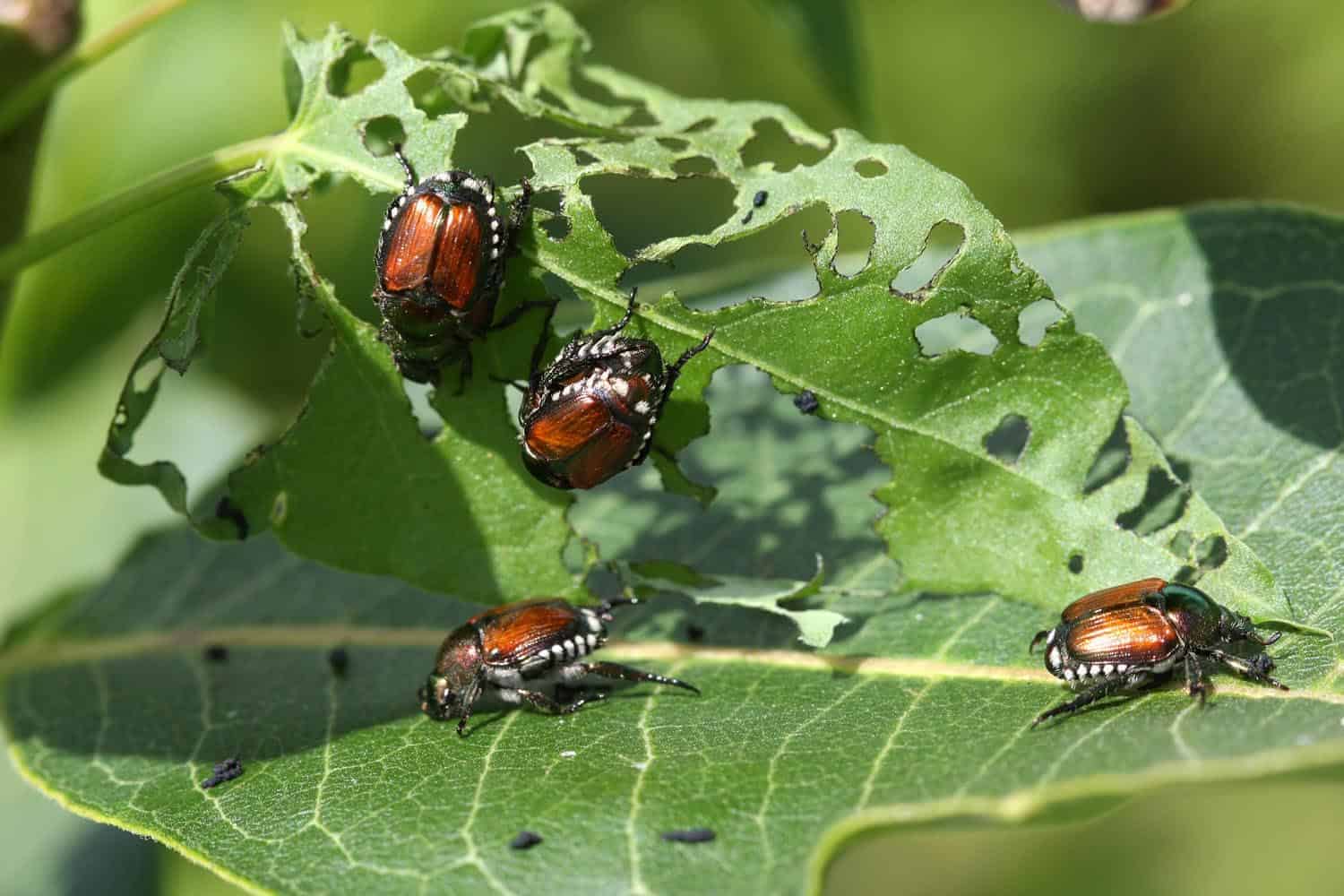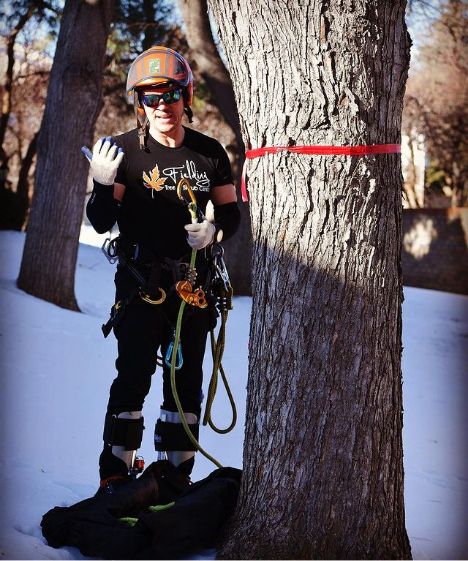As their name suggests, Japanese beetles are native to Japan. The first known instance of Japanese beetles being in the United States was in 1916 in Riverton, New Jersey. Since then, this menace of an insect has made it to the Mile High City. Japanese Beetles (popillia japonica) are arguably one of the most devastating threats to landscaping, particularly flowers. Learn here how to perform Japanese beetle control to ensure a happy landscape.
Identifying the Japanese Beetle and Infestation
What does a Japanese beetle look like? The horticulture experts at Colorado State University give an excellent description of the Japanese beetle:
“The adult Japanese beetle has an oval form and is about 7/16-inch in length. It is generally metallic green with coppery-brown wing covers, which do not quite cover the tip of the abdomen. Along the sides are five patches of whitish hairs. The antennae are clubbed at the end and may spread to a fan-like form.” (Colorado State University Extension)
In simpler nomenclature, it’s the shiny green horned guys that move slowly but will surely eat your shrubs, vines, and flowers. These beetles thankfully aren’t stealthy so there are a few easy ways to spot an infestation. We recommend:
Taking a Closer Look
Adult beetles are easy to spot with the naked eye. If you suspect your plants are under attack, take a look around and see if you can spot any of these winged menaces. You may need to peel back some leaves or look in the crevices of the plant, but once you get one in sight, it’s not hard to miss.
Recognizing Beetles Buzzing
If you see beetles flying around in your yard or garden, it’s a pretty good indicator you have a Japanese beetle infestation. And if you’ve got them bumping into your head or getting comfy on your lawn furniture, then they’ve practically moved in.
Spotting Chewed-Up Leaves and Petals
Japanese beetles feed on the leaves and soft tissues of plants. If you have beetles, you will most likely see large holes in the leaves of your plants. Because the beetles feed on the soft tissue of plants, only the veins in the leaves and the stems of the plants will be left behind. What’s more, Japanese beetles are known to eat more than 300 different species of plants.
Spotting the Japanese Beetle Grubs Before They Become Beetles
A key point in Japanese beetle control is to try and spot grubs before they evolve into beetles. Luckily, you do not have to be a super sleuth to spot and remedy an infestation of grubs. Here is what you want to look for:
Unusual Brown Patches of Plants and Grass
This is especially true if you don’t have a dog. Japanese beetle grubs destroy the root system of plants and grasses. As a result, affected plants and grasses will turn brown as they die.
Easily Uprooted Grass
As a result of decimated roots, infested patches of grass and plants are easily uprooted. The roots are no longer anchored in the soil.
New Scavenging Animals
Birds and many furry creatures enjoy dining on these grubs. Keep an eye out for an increase of these types of animals hunting for insects on your lawn or garden.
Japanese Beetle Life Cycle
According to Colorado State University experts, the Japanese beetle has a one-year life cycle. Adults may begin to emerge from the soil in early June and are usually in full force by early summer – from late June through early August. However, some adults may be found well into September. Japanese beetles remain active until the soil temperature drops below 50 degrees.
Adult beetles actively feed and mate on foliage and flowers of their host plants. Seeking out moist soil, adult beetles lay a small cluster of eggs among the plant roots daily. Surprisingly, a total of 40-60 eggs may be laid by each Japanese beetle female during the course of her 4–8-week life span!
Japanese Beetle Control to Protect Your Flowers
Work together with your neighbors to use a combination of lawn applications, physical removal of the beetles from plants, and soil injections at the base of plants. This will deter the Japanese beetles from advancing to your shrubs, flowers, and vines.
Again, there are 300 plant varieties that these beetles crave and prey on, but here are the ones at the top of their list:
- Virginia Creeper
- Rosebush
- American Linden
- American Elm
- Norway Maple
- American Mountain Ash
- Crabapple & Apple Tree
While the Japanese beetle may not have as devastating an effect as the Emerald Ash Borer beetle, there’s no question of how much of a threat is posed by this oval-shaped archenemy of green-thumbed weekenders. Fortunately, there are several effective treatments to stop Japanese beetles from attacking your landscaping.
Woefully, there is no magic bullet for stopping Japanese beetles in their tracks. Japanese beetles hibernate as grubs in the lawn during the winter months. Adding a standard soil application over your lawn can help kill off grubs. A complete eradication is not guaranteed because of one reason: Japanese beetles are mobile.
Elbow Grease and Soapy Water
Good old-fashioned elbow grease can often be all that is needed to get rid of Japanese beetles. Without an unusually large infestation, you may be able to pick the beetles off of your plants by hand. Drop them into a bowl of soapy water and they will not come back out.
If you have a large number of beetles on your property, getting rid of them may take a little more umph.
Shaking the plant or tree is sometimes all it takes to get rid of the beetles. Place a “beetle receptacle” below the plant or tree in question and give it a firm shake. Japanese beetles should fall off the leaves and into the receptacle.
Avoid using Japanese beetle traps because the traps are not always effective and actually tend to attract more beetles over time. County officials warn that due to population size and explosive growth of the beetle’s, traps have essentially been rendered useless.
Keep shallow pans of soapy water underneath your plants, the adult beetles will fall off plants as a defense mechanism. Landing in the soapy water will ensure their demise.
Japanese Beetle Control for Your Lawn
There is a direct correlation between the length of a blade of grass and the size of its root system. The longer your grass blades are, the more robust and heartier its root system will be. Grass with a vital and robust root system will be better able to withstand the onslaught of grubs.
Watering your lawn or plants when dealing with Japanese beetles can be a delicate balancing act. Japanese beetle eggs and larva are extraordinarily sensitive. The eggs and larva typically congregate within the first few inches of soil. If you can cut back on watering to allow the soil to dry out a little, you increase the odds that many of the larvae and eggs will not survive.
Cutting back on your watering may mean your plants won’t grow as much as they typically would. To combat this, use due diligence in the spring to ensure your plants are as healthy as possible and capable of thriving in drier soil.
Late in the summer, if you find grubs attacking your lawn, you may want to increase your watering. This will help to strengthen the root system.
Japanese Beetle Control with Insecticide
Insecticides for Japanese beetle control are possible as a last resort. Nevertheless, you want to consult an expert before you begin applying an insecticide. Many of these chemicals have side effects that need consideration.
We employ an environmentally safe insecticide. It is a unique solution that provides rapid results, delivering systemic control of many key shade tree pests.
Our insecticide application is a highly effective tool for the management of Japanese beetles. One application will give 30 days of efficacy for insect larvae.
Benefits of Trunk and Soil Injection
Some pesticides and insecticides can be dangerous to birds, other insects, and nearby plants if they enter water runoff.
You can breathe easily and feel confident when you choose our services to manage pests. It is safe and animal friendly!
Environmentally conscientious advantages of trunk and soil injection:
- Little, if any, pesticide applied is wasted to drift or runoff, because it can be applied precisely to where it is needed in the tree.
- Can apply with trunk or soil injection during windy and rainy weather because there is no drift or runoff.
- Trunk injections can be used on sites where soil treatments may not be practical, effective, or appropriate, including trees growing in excessively wet, sandy, compacted, or restricted-soil environments.
- There is little non-target organism exposure because we use a special formula for linden trees that is safe in environmentally-sensitive areas and does not harm the bee population. Your nearby shrubs and plants will also not be affected.
- During soil injection application trees are not wounded.
- The soil injection and trunk injection methods require very few tools and can be completed quickly.
Protecting Your Outdoor Space
Spending time in your outdoor space is precious during the spring and summer months. Your beautiful trees and shrubs create a serene atmosphere for all your favorite activities. We hope this article about Japanese beetle control helps you better protect your trees and landscape from these spring pests.
If you feel your Japanese beetle control battle is a losing endeavor, are unsure which insecticide is right for your trees, or if you want to know what you can do to keep beetles at bay year after year, let our experts with Fielding Tree Care lend a hand.







